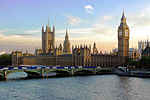National Covid Memorial Wall

The National Covid Memorial Wall in London is a public mural painted by volunteers to commemorate victims of the COVID-19 pandemic in the United Kingdom. Started in March 2021 and stretching more than one-third mile (five hundred metres) along the South Bank of the River Thames, opposite the Palace of Westminster, and just outside St Thomas' Hospital, the mural consists of thousands of red and pink hearts, intending to have one heart for each of the approximately 150,000 casualties of COVID-19 in the United Kingdom at the time of the mural's commencement. The intent was for each heart to be "individually hand-painted; utterly unique, just like the loved ones we’ve lost". The mural was organized by campaign group Covid-19 Bereaved Families for Justice, with the help of the campaign group Led By Donkeys, and painting first commenced in the week encompassing the end of March 2021.
Excerpt from the Wikipedia article National Covid Memorial Wall (License: CC BY-SA 3.0, Authors, Images).National Covid Memorial Wall
Westminster Bridge Road, London Lambeth (London Borough of Lambeth)
Geographical coordinates (GPS) Address Phone number Website Nearby Places Show on map
Geographical coordinates (GPS)
| Latitude | Longitude |
|---|---|
| N 51.5 ° | E -0.12 ° |
Address
St Thomas' Hospital
Westminster Bridge Road
SE1 7EH London, Lambeth (London Borough of Lambeth)
England, United Kingdom
Open on Google Maps









